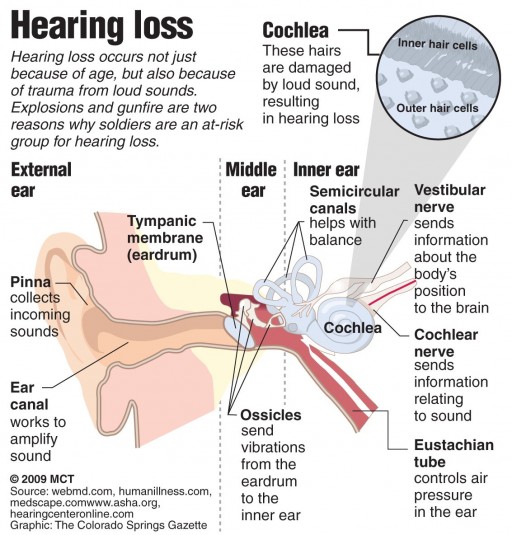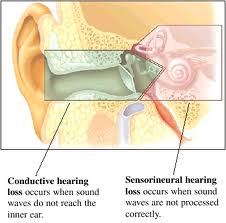The ear is the organ of hearing and balance in vertebrates. The ear converts sound waves in the air, to nerve impulses which are sent to the brain, where the brain interprets them as sounds instead of vibrations. The innermost part of the ear maintains equilibrium or balance. The vestibular apparatus contains semicircular canals which in turn balance you. Any movement by the head, and this apparatus sends a signal to the brain so that your reflex action is to move your foot to balance you.
The ear in humans consist three parts: The outer, the middle, and the inner portions. The outer ear, or pinna, is the structure that we call the  ear. It is the skin covered flap of elastic cartilage, that sticks out from the side of the head. It acts like a funnel catching sound and sending it to the middle portion of the ear. The middle portion contains the ear drum and the connection between the pharynx and the drum, the Eustachian tube. The inner ear contains the sensory receptors for hearing which are enclosed in a fluid filled chamber called the cochlea. The outer and middle ears purposes are only to receive and amplify sound. Those parts of the ear are only present in amphibians and mammals, but the inner ear is present in all vertebrates.
ear. It is the skin covered flap of elastic cartilage, that sticks out from the side of the head. It acts like a funnel catching sound and sending it to the middle portion of the ear. The middle portion contains the ear drum and the connection between the pharynx and the drum, the Eustachian tube. The inner ear contains the sensory receptors for hearing which are enclosed in a fluid filled chamber called the cochlea. The outer and middle ears purposes are only to receive and amplify sound. Those parts of the ear are only present in amphibians and mammals, but the inner ear is present in all vertebrates.
The ear can hear in several different ways. They are volume, pitch, and tone. Pitch is related to the frequency of the sound wave. The volume depends on the amplitude or intensity of the sound wave. The greater the frequency, the higher the pitch. Humans can hear about 30 and 20,000 waves or cycles per second. High pitch sounds produce more of a trebly sound, while low pitch sounds produce a rumbling bass sound.
When a person loses these abilities to comprehend sound, it is referred to as deafness. It can be caused by disease, toxic drugs, trauma, or an inherited disorder. Those causes can be classified as conductive, sensorineural, or both.
A conductive hearing loss results from damage to those parts of the ear which transmit sound vibrations in the air to the fluids of the inner ear. This type of damage is usually to the eardrum or small bones known as ossicles. Ossicles conduct sound from the eardrum to the cochlea. They cannot perform such an action if the eardrum is perforated, if the middle ear cavity is filled with fluid, or if the bones become separated, are destroyed by disease, or are overgrown by a spongy bone (a disorder called otosclerosis). In conductive hearing loss, sound intensity is reduced, but sound isn’t distorted.
Sensorineural hearing loss is more resistant to therapy because it involves damage to the delicate sensory cells of the organ of Corti, which is  located in the cochlea. Sensorineural hearing loss has to do with both distortion of sound and loss of sound intensity. The closer the damaged tissue is to the auditory cortex, the more complex and subtle are the types of distortions. The hair cells of the organ of Corti cannot grow once they are damaged. Sensorineural hearing loss is rarely reversible.
located in the cochlea. Sensorineural hearing loss has to do with both distortion of sound and loss of sound intensity. The closer the damaged tissue is to the auditory cortex, the more complex and subtle are the types of distortions. The hair cells of the organ of Corti cannot grow once they are damaged. Sensorineural hearing loss is rarely reversible.
The hearing losses caused by salicylates such as asprin and the early stages of Meniere’s Disease are reversible, however. The latter condition is characterized by an imbalance of fluid pressures within the inner ear. If this imbalance is correct soon enough, before hair cell destruction has occurred, hearing will return to its normal level. Sensorineural hearing loss is often accompanied by ear noise, or tinnitus, which is a high-pitched ringing heard only by the patient. Because the inner ear has no pain fibers, damage is not accompanied by pain.
Hearing loss is usually measured by an instrument called an audiometer which measures the weakest intensity at which a person can hear at most frequencies in the range of human hearing. The instrument is calibrated against the lowest intensity heard by normal humans at each frequency, according to an international standard. Audiometry can determine the amount of hearing loss-whether it is conductive or sensorineural in nature, and how much of each type of damage has occurred.
Rehabilitation is available for patients with hearing losses. There are lots of programs and resources for these people. Most are special schools. One example might be Cleary’s School for the Deaf. These schools try to provide an environment that is as close to a normal classroom as possible. As a matter of fact, sometimes they use regular classroom’s but they provide special teaching assistants to help individual student’s.
The next step away from a normal classroom is the special schools. This may be a day school or a residential institution. Day schools are organized for one or more typed of handicap. Such schools also exist in all parts of the world. There are, for example schools for the blind, deaf, and mentally retarded in nearly every state in the US.
For children who cannot obtain the schooling they require in their own communities, there are residential schools with dormitories and dining halls that enroll children on a 24 hour a day basis. These schools are designed to serve children who do not have access to normal services or whose handicap makes it difficult to for them to adapt to a regular school. Residential schools are the most common although occasionally there may be a school in a hospital.
